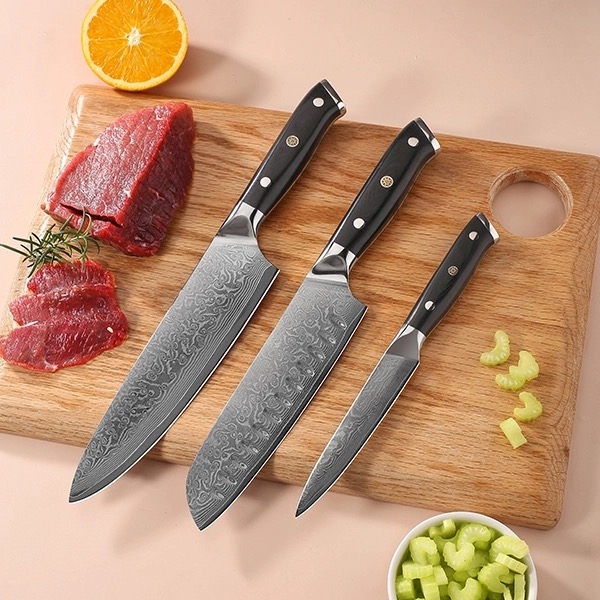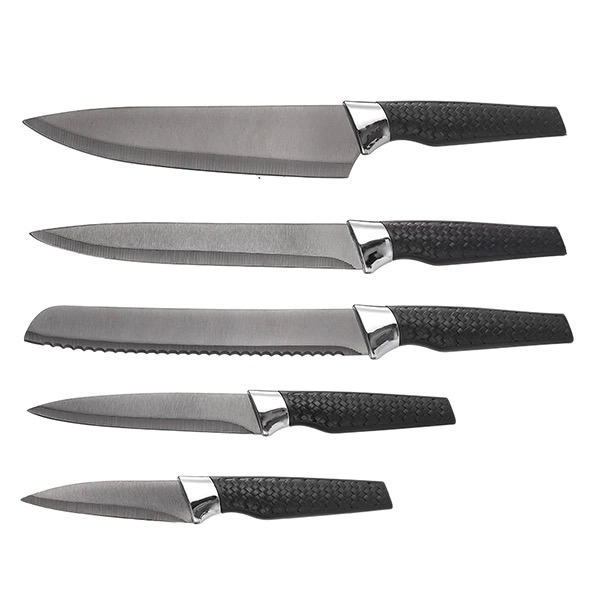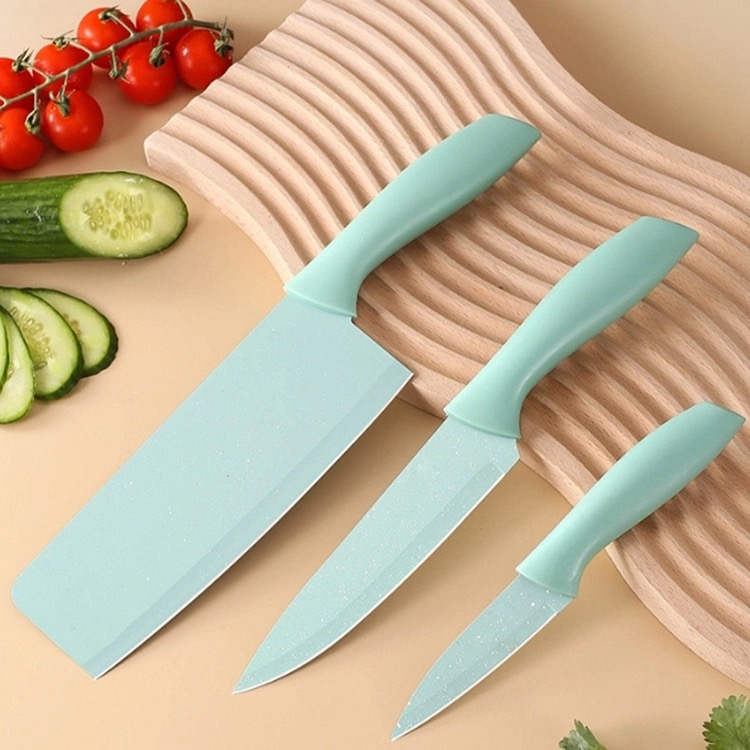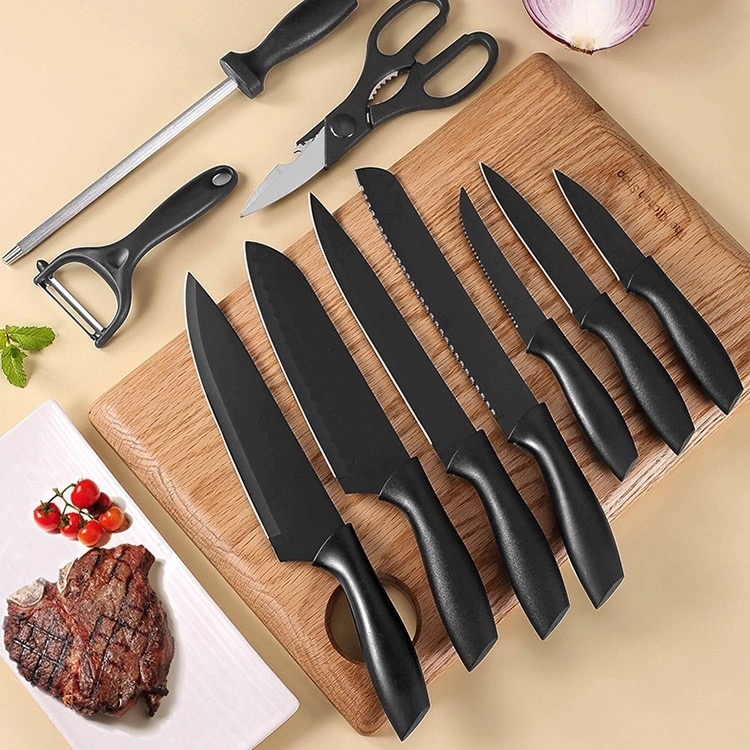Choosing a new knife set can be a daunting task, especially with the myriad of options available on the market today. A good knife set is essential for any kitchen, whether you are a professional chef or a home cook. This article will guide you through the key considerations when selecting a knife set, ensuring you make an informed decision that suits your culinary needs.
Understanding Knife Types
Chef's Knife
The chef's knife is the cornerstone of any knife set. Typically ranging from 8 to 10 inches in length, it is versatile enough for chopping, slicing, and dicing a variety of ingredients. This knife is designed to handle a wide range of tasks, from mincing garlic to slicing through thick cuts of meat. When selecting a chef's knife, consider the weight and balance, as these factors can significantly affect your cutting efficiency and comfort. A well-balanced knife allows for more precise cuts and reduces fatigue during extended use. Additionally, the blade's curvature can influence your cutting technique; a more pronounced curve is ideal for rocking motions, while a straighter edge is better for slicing.
Paring Knife
A paring knife is smaller, usually around 3 to 4 inches long, and is ideal for intricate tasks such as peeling fruits and vegetables or deveining shrimp. This knife excels in tasks that require precision and control, making it a favorite among chefs for delicate work. Look for a paring knife that feels comfortable in your hand, as precision is key in its use. The handle should provide a secure grip, allowing for detailed work without slipping. Some paring knives also feature a pointed tip, which can be useful for tasks like removing seeds or creating decorative garnishes.

Bread Knife
A serrated bread knife is essential for slicing through crusty loaves without crushing them. The length of the blade typically ranges from 8 to 10 inches. Ensure the serrations are sharp and well-formed to make clean cuts. A good bread knife not only slices bread but can also be used for cutting through other soft items, such as tomatoes or cakes. When choosing a bread knife, consider the blade's flexibility; a more rigid blade can provide better control, while a flexible blade can adapt to the shape of the loaf. Additionally, the handle should be comfortable and provide a good grip, especially when cutting through tougher crusts.
Utility Knife
The utility knife is a mid-sized knife that can handle a variety of tasks, from slicing sandwiches to cutting cheese. It usually measures between 4 to 7 inches. This knife is a great addition to your set for those tasks that don't require a full-sized chef's knife. Its versatility makes it a go-to for many kitchen tasks, and it can be particularly useful for preparing snacks or quick meals. When selecting a utility knife, consider the blade's thickness and sharpness, as these factors can affect its performance in different tasks. A well-designed utility knife can bridge the gap between a chef's knife and a paring knife, making it an indispensable tool in your kitchen.
Boning Knife
If you frequently prepare meat, a boning knife is invaluable. It features a thin, flexible blade that allows for precise cuts around bones and joints. This knife is particularly useful for filleting fish or deboning poultry, where accuracy is crucial. Look for a boning knife that offers good maneuverability and a comfortable grip. The blade's flexibility is essential for navigating around bones without damaging the meat. Additionally, consider the length of the blade; a longer blade can be beneficial for larger cuts of meat, while a shorter blade may provide better control for smaller tasks.
Material Matters
Blade Material
The material of the blade significantly impacts the knife's performance and longevity. Common materials include:
Stainless Steel: Known for its resistance to rust and corrosion, stainless steel is a popular choice for kitchen knives. Look for high-carbon stainless steel for added durability and edge retention. This material combines the best of both worlds, offering a sharp edge while being easy to maintain. Stainless steel knives are often less prone to staining and require less frequent sharpening compared to other materials.
High-Carbon Steel: This material is known for its ability to hold a sharp edge longer than stainless steel. However, it requires more maintenance to prevent rusting. High-carbon steel knives are favored by many professional chefs for their superior sharpness and edge retention. They can be more challenging to care for, as they need to be dried immediately after washing to prevent corrosion.
Ceramic: Ceramic knives are lightweight and maintain their sharpness for a long time. However, they can be brittle and are not suitable for tasks that require prying or twisting. Ceramic blades are excellent for slicing fruits and vegetables, as they do not react with food and can help preserve freshness. However, their fragility means they should be handled with care and stored properly to avoid chipping.

Handle Material
The handle of the knife should provide a comfortable grip and be made from durable materials. Common handle materials include:
Wood: Offers a classic look and comfortable grip but requires more maintenance to prevent damage from moisture. Wooden handles can provide a warm, traditional feel and are often ergonomically designed for comfort. However, they may need periodic oiling to maintain their appearance and prevent cracking.
Plastic: Lightweight and easy to clean, plastic handles are often found on budget knife sets. They can come in various colors and designs, making them visually appealing. However, plastic handles may not provide the same level of comfort or durability as other materials.
Metal: Stainless steel handles are durable and provide a modern aesthetic but can be slippery when wet. Metal handles often offer a sleek, professional look and can be very sturdy. However, they may not provide the best grip, so consider options with textured surfaces or rubberized grips for added safety.
Comfort and Ergonomics
When selecting a knife set, comfort is paramount. A knife that feels good in your hand will make cooking more enjoyable and efficient. Consider the following:
Weight: Heavier knives can provide more cutting power, while lighter knives offer better maneuverability. Choose a weight that feels comfortable for your cooking style. Some chefs prefer heavier knives for their stability, while others opt for lighter options for quick, agile movements.
Balance: A well-balanced knife will feel stable and controlled in your hand. Hold the knife to see how it feels; it should not feel top-heavy or awkward. A balanced knife allows for smoother cutting motions and reduces strain on your wrist and hand during prolonged use.
Grip: The handle should fit comfortably in your hand, allowing for a secure grip. Test different shapes and materials to find what works best for you. A good grip can enhance your control over the knife, making it easier to perform precise cuts and reducing the risk of accidents.
The Importance of a Good Knife Block
A knife block not only provides a safe storage solution but also protects the blades from damage. When choosing a knife set, consider whether it comes with a block or if you will need to purchase one separately. Look for a block that allows for proper ventilation to prevent moisture buildup, which can lead to rust. Additionally, some knife blocks come with built-in sharpeners, adding convenience to your kitchen setup. A well-organized knife block can also enhance your kitchen's aesthetic, providing a neat and professional appearance.

Maintenance and Care
Sharpening
A sharp knife is a safe knife. Dull knives require more force, increasing the risk of accidents. Invest in a good sharpening tool, whether it's a whetstone, honing rod, or electric sharpener. Regular maintenance will prolong the life of your knives and enhance their performance. Understanding the different sharpening techniques can also help you maintain the blade's edge effectively. For instance, honing should be done frequently to realign the edge, while sharpening should be reserved for when the blade becomes dull.
Cleaning
Most knife sets are dishwasher safe, but hand washing is recommended to maintain the integrity of the blades and handles. Avoid soaking knives in water for extended periods, as this can damage the handle material. When cleaning, use a mild detergent and a soft sponge to prevent scratching the blade. Always dry your knives immediately after washing to prevent moisture from causing rust or corrosion.
Storage
Proper storage is crucial for maintaining the sharpness and longevity of your knives. In addition to knife blocks, consider magnetic strips or drawer inserts that keep blades protected and organized. Storing knives in a way that prevents them from clashing against each other can help maintain their edges. Additionally, consider using blade guards for individual knives if you prefer drawer storage, as this can prevent accidental cuts and protect the blades from damage.
Budget Considerations
Knife sets come in a wide range of prices, from budget-friendly options to high-end professional sets. Determine your budget before shopping, but remember that investing in a quality knife set can save you money in the long run. A good knife set will last for years, while cheaper options may need to be replaced more frequently. Consider the long-term value of your investment; a high-quality knife set can enhance your cooking experience and improve your culinary skills. Additionally, some brands offer lifetime warranties, providing peace of mind with your purchase.
Conclusion
Selecting the right knife set involves careful consideration of various factors, including the types of knives, materials, comfort, and maintenance. By understanding your cooking needs and preferences, you can choose a knife set that enhances your culinary experience. Remember, a good knife set is an investment in your kitchen that will pay off in both performance and enjoyment. Happy cooking!

Frequently Asked Questions regarding Knife Set
1. What should I look for in a knife set?
When choosing a knife set, consider the types of knives included, the materials used for the blades and handles, the comfort and ergonomics of the knives, and the overall quality of the set. It's also important to think about your cooking style and the tasks you perform most often in the kitchen.
2. How often should I sharpen my knives?
The frequency of sharpening depends on how often you use your knives. For regular home cooks, sharpening every few months is typically sufficient. However, if you notice that your knives are not cutting as easily, it may be time to sharpen them. Regular honing can help maintain the edge between sharpenings.
3. Are expensive knife sets worth the investment?
While expensive knife sets can be a significant investment, they often offer better quality, durability, and performance. High-quality knives are made from superior materials and are designed to last longer, which can save you money in the long run. Additionally, they can enhance your cooking experience and efficiency.
4. Can I put my knives in the dishwasher?
Most knife manufacturers recommend hand washing knives instead of using a dishwasher. Dishwashers can cause damage to the blades and handles due to high temperatures and harsh detergents. Hand washing with mild soap and drying immediately is the best way to maintain your knives.
5. What is the best way to store my knife set?
The best way to store your knife set is in a knife block, on a magnetic strip, or in a drawer with blade guards. Proper storage prevents the blades from dulling and protects them from damage. Avoid storing knives loosely in a drawer, as this can lead to accidents and blade damage.






